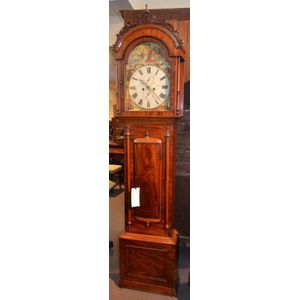Antique English Oak Longcase Clock by Webster of Madely
Rare Webster of Madely antique English oak longcase clock George II, oak case with mahogany banding, blind fretwork to the hood, silvered brass dial, maker Webster of Madely. Webster worked around 1770-90, approx 204 cm high
You must be a subscriber, and be logged in to view price and dealer details.
Subscribe Now to view actual auction price for this item
When you subscribe, you have the option of setting the currency in which to display prices to $Au, $US, $NZ or Stg.
This item has been sold, and the description, image and price are for reference purposes only.
- George Ii - George II (1683 - 1760) was King of Great Britain and Ireland from 1727 until his death in 1760.
- Mahogany - Mahogany is a dense, close grained red-coloured timber from the West Indies and Central America. It was first imported into Europe in the the early 18th century and its use continued through the 19th century. It was popular for furniture making because of its strength, the wide boards available, the distinctive grain on some boards, termed flame mahogany and the rich warm colour of the timber when it was polished.. The "flame" was produced where a limb grew out from the trunk of the tree, and this timber was usually sliced into veneers for feature panels on doors, backs and cornices.
Some terms used to describe mahogany relate to the country from which it originally came, such as "Cuban" mahogany, "Honduras" mahogany etc. However unless the wood has been tested the names assigned are more a selling feature, rather than a true indication of the timber's origin. - Oak - Native to Europe and England, oak has been used for joinery, furniture and building since the beginning of the medieval civilisation. It is a pale yellow in colour when freshly cut and darkens with age to a mid brown colour.
Oak as a furniture timber was superceded by walnut in the 17th century, and in the 18th century by mahogany,
Semi-fossilised bog oak is black in colour, and is found in peat bogs where the trees have fallen and been preserved from decay by the bog. It is used for jewellery and small carved trinkets.
Pollard oak is taken from an oak that has been regularly pollarded, that is the upper branches have been removed at the top of the trunk, result that new branches would appear, and over time the top would become ball-like. . When harvested and sawn, the timber displays a continuous surface of knotty circles. The timber was scarce and expensive and was used in more expensive pieces of furniture in the Regency and Victorian periods. - Hood - In longcase clocks, the hood is the wooden case that surrounds the works and dial, and includes the glass front, which is usually hinged, so the door can be opened to wind the clock or adjust the time. In 18th and 19th century longcase clocks the hood usually slides forward for removal, allowing access to the works.
This item has been included into following indexes:
Visually similar items

Antique French Renaissance style carved bookcase / buffet, 255 cm high, 130 cm wide
Sold by
in
for
You can display prices in $Au, $US, $NZ or Stg.

A Scottish mahogany longcase clock
Sold by
in
for
You can display prices in $Au, $US, $NZ or Stg.

George III English longcase grandfather clock, by William Massey (Nantwich, circa 1790), with 8 day striking movement (bell), needs to be serviced, pendulum, Key, weights and some detached parts included, 214 cm high
Sold by
in
for
You can display prices in $Au, $US, $NZ or Stg.

Antique French Brittany buffet. Approx height 200 cm. Width 81 cm
Sold by
in
for
You can display prices in $Au, $US, $NZ or Stg.
